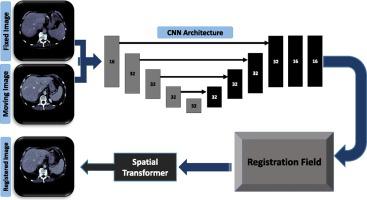IRBM ( IF 5.6 ) Pub Date : 2020-04-25 , DOI: 10.1016/j.irbm.2020.04.002 R. Bhattacharjee , F. Heitz , V. Noblet , S. Sharma , N. Sharma

|
Background
Reliable image comparisons, based on fast and accurate deformable registration methods, are recognized as key steps in the diagnosis and follow-up of cancer as well as for radiation therapy planning or surgery. In the particular case of abdominal images, the images to compare often differ widely from each other due to organ deformation, patient motion, movements of gastrointestinal tract or breathing. As a consequence, there is a need for registration methods that can cope with both local and global large and highly non-linear deformations.
Method
Deformable registration of medical images traditionally relies on the iterative minimization of a cost function involving a large number of parameters. For complex deformations and large datasets, this process is computationally very demanding, leading to processing times that are incompatible with the clinical routine workflow. Moreover, the highly non-convex nature of these optimization problems leads to a high risk of convergence toward local minima. Recently, deep learning approaches using Convolutional Neural Networks (CNN) have led to major breakthroughs by providing computationally fast unsupervised methods for the registration of 2D and 3D images within seconds. Among all the proposed approaches, the VoxelMorph learning-based framework pioneered to learn in an unsupervised way the complex mapping, parameterized using a CNN, between every couple of 2D or 3D pairs of images and the corresponding deformation field by minimizing a standard intensity-based similarity metrics over the whole learning database. Voxelmorph has so far only been evaluated on brain images. The present study proposes to evaluate this method in the context of inter-subject registration of abdominal CT images, which present a greater challenge in terms of registration than brain images, due to greater anatomical variability and significant organ deformations.
Results
The performances of VoxelMorph were compared with the current top-performing non-learning-based deformable registration method “Symmetric Normalization” (SyN), implemented in ANTs, on two representative databases: LiTS and 3D-IRCADb-01. Three different experiments were carried out on 2D or 3D data, the atlas-based or pairwise registration, using two different similarity metrics, namely (MSE and CC). Accuracy of the registration was measured by the Dice score, which quantifies the volume overlap for the selected anatomical region.
All the three experiments exhibit that the two deformable registration methods significantly outperform the affine registration and that VoxelMorph accuracy is comparable or even better than the reference non-learning based registration method ANTs (SyN), with a drastically reduced computation time.
Conclusion
By substituting a time consuming optimization problem, VoxelMorph has made an outstanding achievement in learning-based registration algorithm, where a registration function is trained and thus, able to perform deformable registration almost accurately on abdominal images, while reducing the computation time from minutes to seconds and from seconds to milliseconds in comparison to ANTs (SyN) on a CPU.
中文翻译:

基于学习的腹部CT图像可变形配准方法的评估
背景
基于快速和准确的可变形配准方法的可靠图像比较被认为是诊断和随访癌症以及放射治疗计划或手术的关键步骤。在腹部图像的特定情况下,由于器官变形,患者运动,胃肠道运动或呼吸,要比较的图像彼此之间通常存在很大差异。结果,需要一种能够应对局部和全局大且高度非线性变形的对准方法。
方法
传统上,医学图像的可变形配准依赖于涉及大量参数的成本函数的迭代最小化。对于复杂的变形和大型数据集,此过程在计算上要求很高,导致处理时间与临床常规工作流程不兼容。此外,这些优化问题的高度非凸性导致收敛到局部极小值的高风险。最近,使用卷积神经网络(CNN)进行深度学习的方法通过在几秒钟内为2D和3D图像配准提供计算上快速的无监督方法,已经取得了重大突破。在所有建议的方法中,基于VoxelMorph学习的框架率先以无监督的方式学习使用CNN参数化的复杂映射,通过最小化整个学习数据库中基于强度的标准相似性度量,可以在每对2D或3D图像对之间以及相应的变形场之间移动。到目前为止,Voxelmorph仅在大脑图像上得到了评估。本研究建议在腹部CT图像的受试者间配准的情况下评估该方法,该方法在配准方面比脑部图像面临更大的挑战,因为其解剖学变异性较大且器官变形显着。
结果
在两个代表数据库:LiTS和3D-IRCADb-01上,将VoxelMorph的性能与在ANTs中实现的当前性能最高的基于非学习的可变形配准方法“对称归一化”(SyN)进行了比较。使用两个不同的相似性度量(即MSE和CC),对2D或3D数据(基于图集或成对注册)进行了三个不同的实验。配准的准确性通过Dice得分进行测量,Dice得分量化了所选解剖区域的体积重叠。
所有这三个实验都表明,这两种可变形的配准方法明显优于仿射配准,并且VoxelMorph的准确性与基于参考的非学习配准方法ANTs(SyN)相当甚至更高,并且计算时间大大减少。
结论
通过替代费时的优化问题,VoxelMorph在基于学习的配准算法方面取得了杰出成就,该算法对配准功能进行了训练,因此能够在腹部图像上几乎准确地执行可变形配准,同时将计算时间从数分钟减少到数秒与CPU上的ANT(SyN)相比,从几秒到几毫秒不等。











































 京公网安备 11010802027423号
京公网安备 11010802027423号